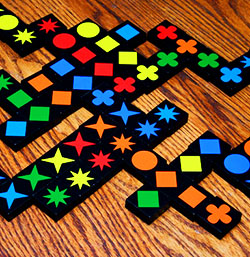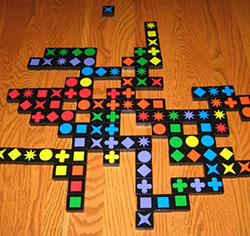

Components
- 108 blocks, in 6 colors and with 6 different shapes.
- one bag
- one instruction booklet
Object of the Game
Create and expand lines of color and shape strategically in order to score the most points.
Setup

You need a paper and pencil to keep the score.
Place all the tiles in the bag.
Each player draws 6 tiles and places them that no other player can see them. This is your deck.
Find the player with the most tiles sharing one characteristic. That player plays those tiles in a row or column and the number of tiles is the score for that first turn.
Game Play
On your turn you can do one of the 3 actions:
- Add one tile to the grid and draw a tile to bring your deck again to 6.
- Add two or more tiles to the grid.
All tiles played must share one attribute (color or shape) and must be placed in the same line.
The tiles must not all have to touch each other.
Again, draw tiles until your deck has 6 tiles again.
Trade some or all of your tiles for different tiles.
Tutorial Video
Adding Tiles
All tiles must connect to the grid and form a line of two or more tiles.
A line is either all one shape or all one color.
Tiles that are added to a line must share the same attribute as the tiles that are already in that line.
You may play multiple tiles on your turn as long as all tiles played are the same color or the same shape and are placed in the same line. You cannot play two tiles that are exactly the same.
At least one of the tiles you play must touch (side to side) a tile that has already been played and match the tile in color or shape. Any tiles that touch each other are part of a line. Lines are either all one shape or all one color, without any duplicates.

A blue square and a yellow square can be added to the opening move to create a line of squares.
The tiles you play must be added to the same line, but they do not have to touch each other.

You can add a tile to both ends of a line In one turn.
There cannot be duplicate tiles in a line. For example, a line of squares can only have one blue square. A line can never be longer than six tiles.
As the game progresses, spaces will be created where no tile can be played.
Trading Tiles
If your are unable to add tiles to the grid on your turn, you must trade in some or all of your tiles.
Set aside the tiles you want to trade, then draw replacement tiles.
Finally, mix the tiles that you traded away back into the bag.
Scoring

When you create a line, you score one point for each tile in that line (including the tiles that already existed on the grid).
When a tile is part of two different lines, it will score 2 points.
You score 6 bonus points whenever you complete a line of 6 tiles, which is called a Qwirkle.

Lines of more than 6 tiles are not allowed.
End of the Game
When there are no more tiles left, the play continues as before but players don't replenish their decks at the end of their turns.
The first player who uses all of his tiles ends the game and gets a 6 points bonus.
The player with the highest score is the winner of the game.
Sample Game
-
Anna plays three red tiles to start the game. She scores 3 points.

-
Chris scores 4 points for the red line and 3 points for the square line. 7 points total.

-
Sally scores 2 points for the circle line and 2 points for the blue line. 4 points total.

-
Dave scores 2 points for the green line, 2 points for the clover line and two points for the diamond line.
6 points total.

-
Anna scores 4 points for the green line and 3 points for the circle line.
7 points total.

-
Chris scores 4 points for the horizontal square line and 2 points for the vertical square line. 6 points total.

-
Sally scores 3 points for the starburst line. 3 points total.

-
Dave scores 3 points for the orange line. 3 points total.

-
Anna scores 2 points for the yellow line, 4 points for the diamond line and 4 points for the circle line. 10 points total.

-
Chris scores 4 points for the starburst line and 5 points for the red line. 9 points total.

-
Sally scores 6 points for the red line plus 6 points for making a red Qwirkle. She also scores 3 points for the blue line and 3 points for the line of criss-cross shapes. 18 points total.

-
Dave scores 5 points for the horizontal square line, 2 points for the vertical square line and 2 points for the second horizontal square line. 9 points total.

Continue Reading


